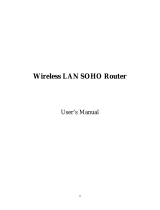
v
Contents
1 Introduction .................................................................................................................................. 1
1.1 Overview ................................................................................................................................ 1
1.2 Getting to know your device .................................................................................................. 1
2 Quick setup ................................................................................................................................... 4
2.1 AP mode ................................................................................................................................. 4
2.2 Client mode ............................................................................................................................ 7
2.3 Example of AP mode and client mode ................................................................................. 10
2.4 Universal repeater mode ..................................................................................................... 16
2.5 WISP mode ........................................................................................................................... 22
2.6 Repeater mode ..................................................................................................................... 31
2.7 P2MP mode .......................................................................................................................... 41
2.8 Example of repeater mode and P2MP mode ....................................................................... 45
2.9 Router mode ........................................................................................................................ 52
3 Web UI ......................................................................................................................................... 56
3.1 Login ..................................................................................................................................... 56
3.2 Logout .................................................................................................................................. 58
3.3 Web UI layout ....................................................................................................................... 59
3.4 Common buttons ................................................................................................................. 59
4 Status ........................................................................................................................................... 60
4.1 System status ....................................................................................................................... 60
4.2 Wireless status ..................................................................................................................... 63
4.3 Statistics ............................................................................................................................... 65
5 Network....................................................................................................................................... 70
5.1 LAN setup ............................................................................................................................. 70
5.2 MAC clone ............................................................................................................................ 77
5.3 DHCP server ......................................................................................................................... 79




















